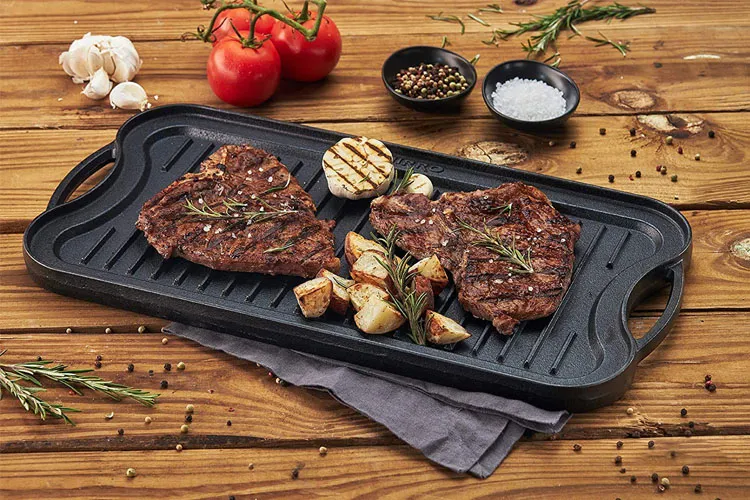
enameled cast iron vs regular
Enameled Cast Iron vs. Regular Cast Iron A Comprehensive Analysis
When it comes to cookware materials, cast iron has earned a prestigious position in kitchens around the world. Renowned for its excellent heat retention and even cooking capabilities, cast iron cookware has been cherished by home cooks and professional chefs alike for centuries. Within the realm of cast iron, two varieties stand out enameled cast iron and regular (or bare) cast iron. Each has its unique properties, advantages, and considerations that cater to different cooking needs and preferences.
What is Regular Cast Iron?
Regular cast iron cookware is made by pouring molten iron into a mold, creating products that are robust, heavy, and extremely durable. This type of cookware is known for its excellent heat retention and distribution, which allows for consistent cooking temperatures. It can withstand high temperatures, making it ideal for searing, frying, and baking.
One distinct characteristic of regular cast iron is its natural non-stick surface that develops over time, a result of seasoning. Seasoning is the process of applying fat or oil to the surface of the cast iron, which is then baked onto the cookware. This creates a protective layer that enhances its non-stick properties, improves its resistance to rust, and contributes to its flavor-enhancing qualities during cooking.
However, regular cast iron requires diligent care and maintenance. It must be seasoned regularly and cleaned properly—typically by hand washing and drying immediately to prevent rust. Additionally, it is prone to reacting with acidic foods, which can strip away the seasoning layer and impart an off-flavor. Despite these challenges, many culinary enthusiasts appreciate the craftsmanship and the resulting flavor enhancement regular cast iron provides.
What is Enameled Cast Iron?
Enameled cast iron is a variation of regular cast iron, coated with a glaze (enamel) that provides a non-porous, smooth surface. This enamel coating comes in various colors and allows for a more aesthetically pleasing presentation. Enameled cast iron shines in its versatility, as it can be used for both stovetop and oven cooking without the need for seasoning.
enameled cast iron vs regular

One of the major advantages of enameled cast iron is its ease of maintenance. Unlike regular cast iron, it does not require seasoning and is generally dishwasher safe, making it convenient for everyday use. The enamel finish also prevents reactive interactions with acidic ingredients like tomatoes or citrus, allowing for a broader range of cooking applications without fear of flavor alteration.
However, enameled cast iron is not without its drawbacks. The enamel coating can chip or crack if dropped or subjected to extreme temperature changes, which could compromise the functionality and aesthetic appeal. Moreover, while it still retains heat well, enameled cast iron may not reach as high temperatures as bare cast iron, making it less ideal for certain high-temperature cooking methods.
Comparative Analysis
When choosing between enameled and regular cast iron, one’s cooking style and preferences play a significant role. For those who enjoy traditional cooking techniques, are willing to invest time in maintenance, and appreciate the natural non-stick surface that develops, regular cast iron could be the best choice. It’s perfect for frying, baking artisan bread, or developing complex flavors through seasoning.
Conversely, if you prefer low-maintenance cookware that can handle a variety of cooking methods with ease, enameled cast iron will be your go-to. Its versatility and stylish appearance make it suitable for both cooking and serving. It allows cooks to sauté, simmer, bake, and serve all from the same pot without worrying about the seasoning process.
In terms of price, enameled cast iron tends to be more expensive than regular cast iron, reflecting its additional manufacturing processes and aesthetic value. However, both types of cookware are durable and, with proper care, can last a lifetime.
Conclusion
Ultimately, the choice between enameled and regular cast iron cookware boils down to personal preference and cooking habits. Each type has its own benefits and considerations, catering to different needs in the kitchen. Whether you opt for the traditional charm and seasoning ritual of regular cast iron or the modern convenience and versatility of enameled cast iron, both choices offer exceptional culinary experiences and have secured a place in the hearts of many cooks worldwide. With a deeper understanding of these two types of cast iron, you can make an informed decision that enhances your culinary adventures.
-
Black Cast Iron Pancake Pan - Baixiang County Zhongda Machinery | Non-Stick, Heat ResistantNewsAug.09,2025
-
Versatile Cast Iron Ovens: Non-Stick, Round & XL Dutch OvensNewsAug.09,2025
-
High Quality Kitchen Durable Black Round Cast Iron Cookware Pancake Crepe Pan|Non-Stick&Heat RetentionNewsAug.09,2025
-
High Quality Kitchen Durable Black Round Cast Iron Cookware Pancake Crepe Pan With Wooden Handle-Baixiang County Zhongda Machinery Manufacturing Co., Ltd.|non-stick surface&even heat distributionNewsAug.09,2025
-
High Quality Kitchen Durable Black Round Cast Iron Cookware Pancake Crepe Pan With Wooden Handle-Baixiang County Zhongda Machinery Manufacturing Co., Ltd.|Non-Stick, Heat Retention, DurableNewsAug.08,2025
-
High Quality Cast Iron Cookware - Baixiang County Zhongda Machinery | Nonstick, Heat RetentionNewsAug.08,2025


